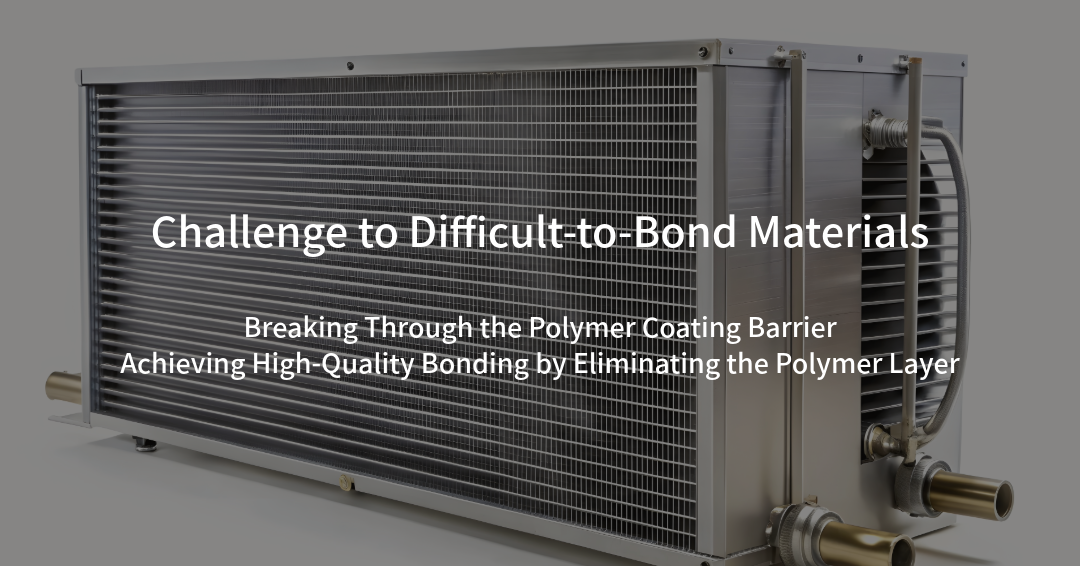Many metal components are coated with metal or resin for purposes like corrosion prevention. If the coating is metallic, it’s typically plating; if it's organic like resin, it's a polymer layer. Our last post discussed the impact of tin plating on welding and bonding.
This time, we focus on bonding metal materials protected by a resin surface. We will refer to this thin resin covering as the polymer coat.
Welding polymer-coated metals is difficult. Since the metal's melting point far exceeds the polymer's combustion temperature, welding a coated material directly causes the organic material to burn, leaving the weld joint full of defects. Any process involving metal fusion requires the organic material to be removed.
But what about solid-state bonding like ultrasonics? The ideal scenario is one where the polymer layer is completely displaced at the joint interface to ensure a strong bond, while remaining intact around the joint to maintain corrosion protection.
The Ultrasonic Complex vibration Bonding (USCB) technology developed by LINK-US breaks through this "polymer coat barrier," enabling high-quality bonding without excessive polymer removal.
table of contents
The Problem with Polymer-Coated Metal Materials
The polymer layer protecting the metal surface acts as an "obstacle" to welding and bonding. The issues with polymer-coated materials include:
- Welding Defects: Internal defects reduce strength and electrical conductivity.
- Spatter: Severe spatter generation negatively impacts quality through foreign material contamination and poor aesthetics.
- Bonding Failure (Ultrasonics): Reduced friction and scrubbing action lower joint strength and electrical performance.
- Reduced Corrosion Protection: Excessive peeling or damage to the coat layer during bonding compromises its protective function.
Maintaining corrosion protection and insulation in hot and humid environments is an increasingly strict requirement as product service life extends.
LINK-US’s Approach: Realizing Low-Intrusion Solid-State Bonding
The major advantage of USCB is its low-intrusion solid-state bonding. The unique scrubbing action of the ultrasonic complex vibration, which traces an elliptical path, generates minute friction and plastic deformation at the contact interface. This effectively breaks down and disperses the surface polymer layer and oxide film, achieving an atomic-level bond between the base materials.
The results are:
- No Pre-Treatment Needed: The polymer layer removal process on the joint surface is eliminated.
- Minimized Thermal Impact: Reduced intrusion and damage to the polymer layer near the joint.
- Solid-State Bonding: Base material physical properties (thermal, electrical conductivity, mechanical strength) are maintained.
- Simultaneous Multi-Point Bonding: Production efficiency is maintained even for large-area or multi-point joints.
The biggest innovation is transforming the process from having to "strip before you join" to being able to "join directly."
Expected Benefits
- Air Conditioning/Heat Exchangers: Applicable to bonding corrosion-coated aluminum fins and tubes. Achieves stable conductivity and strength while preserving the coat layer outside the joint.
- Automotive Components: Allows direct bonding of rust-proofed copper and aluminum terminals, contributing to lighter and more durable electrical components.
- Electronics/PCB Assembly: Applicable to bonding insulated pads or component leads. Connecting without thermal deformation maintains the stability of microstructures.
Key Advantages
- Process Reduction: Eliminates steps like coat removal and line stoppages for contamination cleanup, drastically improving productivity.
- Improved Yield: Reduced defects from thermal damage to the coat layer or coat peeling ensures stable quality.
- Cost Reduction: Shorter processes combined with a lower defect rate compress manufacturing costs.
- Expanded Design Freedom: Component selection is no longer constrained by the coating process, increasing design and manufacturing flexibility.
Future Outlook
As electrification and energy efficiency advance, coating materials will become increasingly diverse and sophisticated. New surface treatments—including insulating coats, chemical resistance layers, and composite resin films—will emerge, making conventional welding and soldering methods increasingly challenging.
LINK-US's USCB, with its unique characteristics of "low heat, low energy, and dissimilar material compatibility," can flexibly adapt to these future materials. It transforms the presence of coating materials from a constraint into an opportunity for expanding design freedom.
Summary
While polymer coatings protect materials from corrosion and degradation, they have long presented a major barrier to bonding. LINK-US's Ultrasonic Complex Vibration Bonding breaks through this wall by reliably joining the base metals while displacing the polymer layer.
This new process, which simultaneously achieves high-quality bonding and improved manufacturing efficiency, holds immense potential across a wide range of industries, including HVAC, automotive, and electronics.
→ If you have challenges with surface-coated material bonding, contact LINK-US for a consultation.

